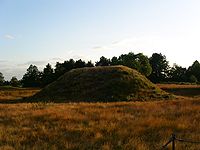Archaeology of Anglo-Saxon England
This article has multiple issues. Please help improve it or discuss these issues on the talk page. (Learn how and when to remove these messages)
|
The archaeology of Anglo-Saxon England
Burial
One of the aspects of early Anglo-Saxon society that we know most about is their burial customs, which we have discovered from archaeological excavations at various sites, including Sutton Hoo, Spong Hill, Prittlewell, Snape and Walkington Wold, and we today know of the existence of around 1200 Anglo-Saxon pagan cemeteries. There was no set form of burial amongst the pagan Anglo-Saxons, with cremation being preferred amongst the Angles in the north and inhumation amongst the Saxons in the south, although both forms were found throughout England, sometimes in the same cemeteries. When cremation did take place, the ashes were usually placed within an urn and then buried,[1] sometimes along with grave goods.[2] Free Anglo-Saxon men were buried with at least one weapon in the pagan tradition, often a seax, but sometimes also with a spear, sword or shield, or a combination of these. Wealthy individuals were buried with rich grave goods. There are also various recorded cases of animal skulls, particularly oxen but also pig, being buried in human graves, a practice that was also found in earlier Roman Britain.[3]

Eventually, in the 6th and 7th centuries, the idea of burial mounds began to appear in Anglo-Saxon England, and in certain cases earlier burial mounds from the Neolithic, Bronze Age, Iron Age and Romano-British periods were simply reused by the Anglo-Saxons. It is not known why they adopted this practice, but it may be from the practices of the native Britons.[4] Burial mounds remained objects of veneration in early Anglo-Saxon Christianity, and numerous churches were built next to tumuli. Another form of burial was that of ship burials, which were practiced by many of the Germanic peoples across northern Europe. In many cases it seems that the corpse was placed within a ship which was then either sent out to sea or left on land, but in both cases then set alight. In Suffolk however, ships were not burned, but buried, as is the case at Sutton Hoo, which it is believed, was the resting place of the king of the East Angles, Raedwald.[4] Both ship and tumulus burials were described in the Beowulf poem, through the funerals of Scyld Scefing and Beowulf respectively.
There are also many cases where corpses have been found decapitated, for instance, at a mass grave in Thetford, Norfolk, fifty beheaded individuals were discovered, their heads possibly having been taken as trophies of war. In other cases of decapitation it seems possible that it was evidence of human sacrifice or execution.[2]
See also
- Anglo-Saxon hoards
- Anglo-Saxon art
- Anglo-Saxon numismatics
- Anglo-Saxon glass
- Anglo-Saxon architecture
- Burial in Early Anglo-Saxon England
References
- ^ See, for example, the Wold Newton urns - http://www.woldnewton.net/files/urns
- ^ a b Hutton (1991:275)
- ^ Hutton (1991:274)
- ^ a b Hutton (1991:277)
